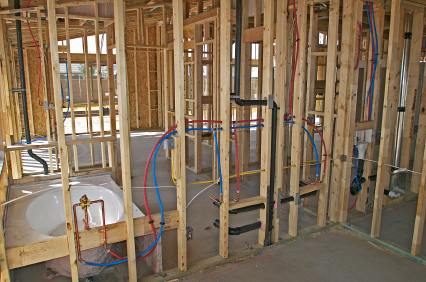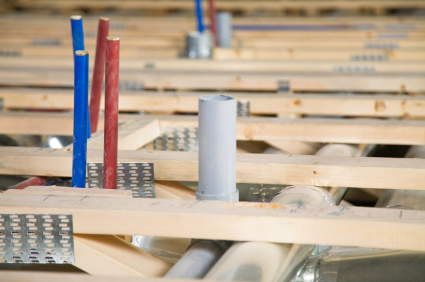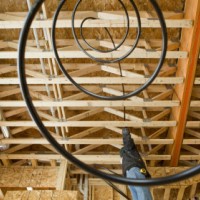Plumbing with PEX
Are you working with your builder to plan construction for a new home or remodel your existing home? Maybe you are just contemplating your next move. Chances are you have heard about PEX plumbing and have wondered if it's a suitable option for your residence as compared to the more traditional piping material, copper. Although PEX (cross-linked polyethylene) is a relatively newer piping material than copper or even chlorinated polyvinyl chloride (CPVC), it has a successful history of use in residential applications. PEX has been used in Europe since the 1960s and has experienced significant growth in the United States since its introduction in the 1980s. In a highly regulated industry, PEX piping undergoes extensive testing and certification to meet strict performance requirements to ensure a quality material that provides healthy drinking water.

What Is PEX?
PEX is a light-weight, flexible pipe that is manufactured from 100% virgin high-density polyethylene (HDPE) with cross-linked polymer bonds. Cross-linking polymers produces a thermoset material that is stronger and more durable than a thermoplastic material, such as CPVC. The elasticity of PEX, its ability to expand and contract, provides protection from noisy water hammer resistance and cracking or splitting of freezing water-filled pipes. PEX can withstand high temperatures as well, with a maximum working temperature of 180?F at 100 psi. Historically speaking, metallic pipe materials experience degradation from corrosion and/or mineral buildup. PEX pipe will not pit or corrode, and it is resistant to mineral buildup, chlorine, and chloramine. PEX pipe that complies with ASTM F876, Standard Specification for Cross-Linked Polyethylene (PEX) Tubing, and ASTM F877, Standard Specification for Cross-Linked Polyethylene Plastic Hot and Cold Water Distribution Systems, is approved for use in all model plumbing and mechanical codes across the United States and Canada. This allows PEX to be used in a variety of applications around the home. Whether you are replacing existing rigid pipe or installing new supply lines, you should rest assured that PEX is an appropriate choice. PEX can also be used as a supply line in radiant floor heating systems, residential fire suppression systems, or a snow and ice melt system under sidewalks and driveways.
Why Use PEX?
"Market demand and price control were the driving factors in deciding to use PEX as opposed to copper. The fluctuating cost of copper made it difficult to control prices. PEX material costs remained relatively consistent, easing the ability to control cost." Scott Wenland, Wenland Custom Homes
PEX offers several material advantages, but if that isn't enough to consider its use in your home, compare the costs. PEX piping systems are relatively easy to install when compared to copper or CPVC, keeping down labor costs. Combine that with low material cost and low operational cost, and you are keeping money in your pocket. Let's consider the traditional alternative. Since the late 1990s, the price of copper has increased over 700%, to well over $4.00/lb, according to COMEX. The high price of copper has incited an epidemic of copper theft across all 50 states. The U.S. Department of Energy assesses the damage of copper theft on a yearly basis and recently suggested that it costs our nation's economy approximately $1 billion a year. Copper theft occurs in both vacant, foreclosed homes and new residential builds. Replacing missing supply lines and repairing damaged finishes or structure will not only cost you money but will also increase the time of new construction or will delay closing for the new owner.
Depending on how a PEX system is installed, the installation costs can be kept to a minimum because there are fewer fittings for a plumber to join. PEX pipe is joined by using mechanical connections, a safer and simpler procedure than soldering copper with a blowtorch or applying chemical adhesives to CPVC connections. A comparison of the material costs of various 3/4" supply line pipe materials at local home improvement stores showed that Type M Copper was $1.50 - $2.00 per linear foot, CPVC was $0.50 - $0.60 per linear foot, and PEX was $0.40 - $0.50 per linear foot; it's evident that PEX could be a game changer.
I recently had the opportunity to speak with a local builder, Scott Wenland of Wenland Custom Homes in Sylvania, Ohio, about PEX piping systems. He was reluctant at first to switch from copper to PEX but has been using PEX piping systems in the custom homes he has built for the last 8 years. Wenland states, "Market demand and price control were the driving factors in deciding to use PEX as opposed to copper. The fluctuating cost of copper made it difficult to control prices. PEX material costs remained relatively consistent, easing the ability to control cost."


PEX piping also offers a homeowner water conservation and energy-efficient savings. The traditional rigid pipe trunk and branch installation can be very inaccessible, so when repair or remodeling is necessary, costs increase due to the necessary removal and replacement of floor, wall, or ceiling finishes. When PEX pipe is installed with home-run supply lines from a manifold, it is more accessible, allowing less invasive activity during repairs or remodeling. A manifold would allow a plumber to shut down water to an affected area instead of an entire house, making things easier for the plumber and reducing your costs. PEX piping is also energy-efficient: the material doesn't absorb heat like metallic piping, resulting in less water heat loss. If properly designed, a PEX system can conserve water by reducing the time it takes for hot water to reach a fixture.
After a new installation or the end use of PEX, the material can even be recycled. While PEX cannot be melted and reused to form new piping, it can be recycled into an extender for other durable plastic products. PEX piping is ground and pulverized into small particles that are blended with polyethylene and melted into other durable plastic products.
PEX Design and Installation
While PEX is approved for use by all model codes, it is a good idea to check with your local jurisdiction to be sure it is approved for use in your area prior to design and installation. Some jurisdictions use older model codes that may not include PEX piping. According to the Residential PEX Water Supply Plumbing Systems design guide that was prepared in November 2006 by the NAHB Research Center, in conjunction with the Plastics Pipe Institute, the Plastic Pipe and Fittings Association, and the Partnership for Advancing Technology in Housing, designing a PEX system should incorporate optimal groupings of fixtures, a centralized distribution point, spaces for bundled runs of PEX pipe, and assemblies of building components that allow for ease of installation.
PEX Installation Configurations
- PEX piping can be installed in a variety of configurations. It can be installed like traditional rigid piping using a trunk and branch configuration, where the main line (trunk) directs water to fixture supply lines (branches).
- The most efficient installation of PEX piping is a home-run configuration, where a central manifold directs water to dedicated piping that serves a fixture. A home-run configuration allows for pressure control and the elimination of fittings.
- Another type, remote manifold configuration, combines the trunk and branch and home-run configurations. Remote manifold configuration uses a main line to direct water to a remote manifold that serves a group of multiple fixtures in a similar location. Dedicated piping is attached to the remote manifold, supplying water to each fixture.
Which configuration you choose should depend on the type and size of your home. "Smaller homes, where the distance from a manifold to fixtures is somewhat short, can really benefit from the efficient installation of a home-run configuration," says Wenland. "However, larger homes with longer distances can become a source of dissatisfaction for an owner waiting on hot water. I prefer to use a trunk and branch configuration with a recirculating pump in larger homes. This configuration provides an owner with hot water rather quickly."
Types of PEX Piping
PEX piping is available as white, black, or color-coded pipe that can serve to distinguish water type, red for hot and blue for cold. PEX pipe sizes range from 1/4" to 2". The most common sizes for domestic water supply lines are 1/2", 3/4", and 1". The tools, fittings, and rings needed to perform an installation depend on which PEX pipe you select for installation. Each manufacturer has specific fittings and rings that work with the piping they provide, and each type of fitting and ring requires specific tools for proper installation. In general, fittings are either a polymer or metal material that is inserted into a PEX pipe. Three types of rings -- compressed, crimped, and push type connections -- are made from PEX, metal, copper, or stainless steel material to secure the fitting inside the PEX pipe. Tools necessary for installation can include a pipe expander, cutter, and uncoiler; pressing, clamping, and crimping tools; and attachment tools. During the installation of PEX pipe, bending of the pipe is allowed as long as the pipe is properly secured to allow pipe movement and not impede the flow of water. It is important to read and follow the manufacturer's installation instructions, as with any product or material,† to be sure the PEX pipe is properly installed.
Without doubt, copper pipe is the traditional, tried, and true material for residential plumbing systems and more commonly installed today than any other plumbing pipe on the market. PEX piping systems offer a real alternative, though. Nothing's perfect: PEX pipe has its disadvantages, too. For instance, hot water lines in open spaces like basement ceilings don't look nearly as professional as copper piping, because they tend to gently sag after an extended period of use. Wenland states, "In some cases, we've installed copper pipe in unfinished basement ceilings and PEX through concealed spaces in the first and second floors of the home in order to ensure the unfinished ceiling piping remains rigid and straight." Other disadvantages include PEX's inability to withstand UV rays or be installed near areas where water temperatures could exceed 180įF at 100 psi. These disadvantages, combined with the past failures of polybutylene (PB) pipe and a general hesitation by plumbers to use PEX due to inexperience with installation and the material, tend to stymie its full acceptance and use.
You know your project better than anybody. If your home has the right set of characteristics and you have or your installer has the proper skill set, you may find that PEX pipe could be just the right type of plumbing.

Jeff Calcamuggio
Jeff is an Editor-at-Large for Buildipedia.com who writes and edits Featured At Home and Knowledgebase content. Prior to joining Buildipedia, Jeff's work experience included carpentry, construction documentation, specification writing, construction administration, project management, and real estate property inspection. Jeff is a member of the Construction Specifications Institute (CSI) and an educator at Columbus State Community College and enjoys challenging DIY home improvement projects.
†




